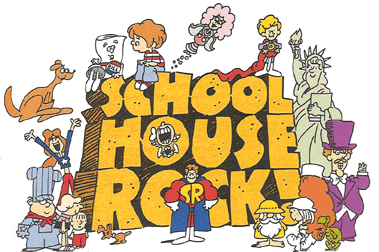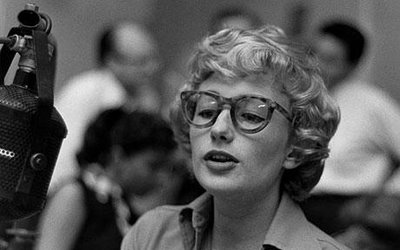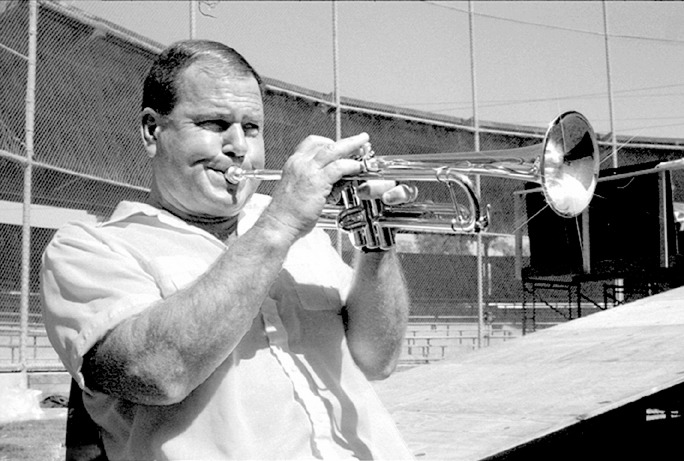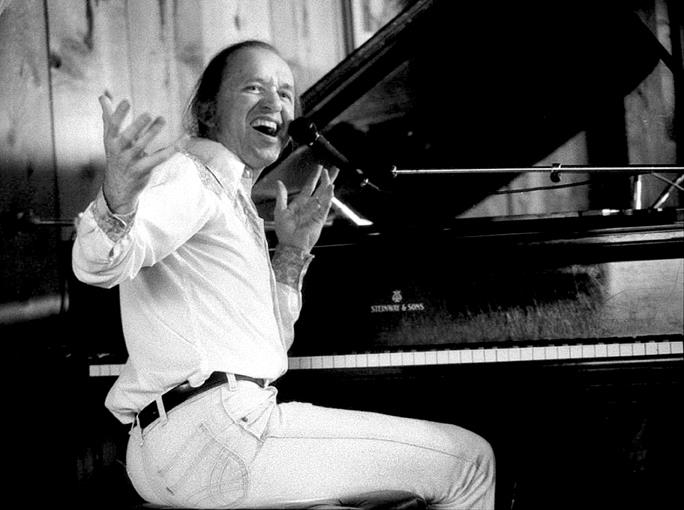Holly Hutchings and I made this extra special, multiple-interview episode about the classic children’s cartoon “Schoolhouse Rock” five years ago, but we never released it on the podcast feed because of copyright concerns about the music. But when I heard last week it was the 50th anniversary of the show, I knew you had to hear it — especially since we have an interview with one of the creators, George Newall, who died back in October. So Holly stripped out the music and remastered the show. I’m delighted so many of you can now hear the story.
In this Grammar Girl episode, you’ll hear all this and more:
- How the idea for “Schoolhouse Rock” came to be.
- The memories of the many marketers, creative writers, and jazz legends who made it happen.
- The story of the first, magical song they created.
- How teachers, and even college professors, still use “Schoolhouse Rock” today.
How did Schoolhouse Rock come to be?
HOLLY
“Schoolhouse Rock” was a short animated program that taught concepts like math, civics, and of course, grammar. It ran on ABC Saturday mornings during cartoons from 1972 until the early eighties. “Schoolhouse Rock” began when David McCall of the advertising agency in McCaffrey and McCall in New York realized that his child could sing all the rock songs of the day, but was struggling to remember the multiplication tables they were learning in school. McCall tasked fellow man George Newell with the job of finding someone who could put math to music and not be boring about it. Here’s George:
GEORGE NEWELL
I did know a fellow named Bob Dorough, and Bob came up to our agency. We had a meeting, and David told him what he wanted to do, and Bob said, ‘Okay, I’ll be back in three weeks.’ And in three weeks, he came back with the song “Three is a Magic Number.” And the genius of the song is that instead of just…there used to be when I was a kid, a thing on the radio called “The Singing Lady,” and she just sang these things. But Bob put them in a context. “It takes three legs to make a stool, it takes three of this, three of that.” That last line before he got into the counting was “A man and a woman had a little baby. There were three in the family. Three is a magic number.” We just looked at one another and were astonished.
HOLLY
Newall went right to the art department and found his partner, Tom Yohe, who ran the department at the agency. He asked Yohe to create sketches to match the lyrics of their new tune. The ad agency had the ABC account — actually their biggest account. They knew ABC was looking for some educational programming, so they created a storyboard of what the song could look like as a cartoon. ABC loved the idea and the drawings. They signed on to run the shorts under one condition. Yohe had to illustrate them.

HOLLY
So you said you guys looked at each other after you heard “Three is a Magic Number,” and I imagined magic happening, like this could be a thing!
GEORGE NEWELL
You know, I started to get tears in my eyes. I mean, you’ve gotta think that this guy Bob was from Arkansas, and he had this incredible southern drawl, and he had a nice, really nice soft voice. And, it was a moment that struck us all. And the rest was history.
Schoolhouse Rock’s memorable characters and songs
HOLLY
The show just saw its 45th anniversary and is known all over, even being referenced by President Obama when asked in an interview how government could work better.
NEWS REPORTER
When they get back in session, do you believe you know the way to get things done for the American people so that we don’t have another shutdown of the government, which effectively punishes everybody else except the lawmakers?
PRESIDENT OBAMA
There is a very simple way of doing this, which is … maybe you’re not old enough to remember “Schoolhouse Rock,” but..
NEWS REPORTER
No, I remember it.
PRESIDENT OBAMA
Remember how the bill gets passed?
GEORGE NEWELL
The songs are all different. Some of them, the music carries them, and on others it is the, it’s the art. It’s Tom’s cartooning that carries them. And a good example of that is “I’m just a Bill,” and that was written by Dave Frishberg. But it’s a very straightforward song. They’re no gimmicks to it. It just takes you through the process. But the character that Tom designed was just so memorable that it’s used constantly.
HOLLY
Newell says they weren’t aware at the time of making the show that they were creating something that would become so fundamental to so many people. They were just having a good time. Many people contributed to making “Schoolhouse Rock” the success it is.

Jazz legends like Lynn Ahrens, Blossom Dearie and Jack Sheldon and others voiced the lyrics, and gifted writers like Dave Frishberg, George Newell, and Bob Dorough developed the memorable lyrics.

© Brian McMillen / brianmcmillen@hotmail.com
It was a collaborative environment though, and each person dabbled in different roles. If an animator had an idea, they’d do it. If the singers had a better lyric, it would get changed. Vocalist for the first song and many more, Bob Dorough passed away in April of 2018. His daughter, Aralee Dorough remembers “Schoolhouse Rock” from the beginning.
ARALEE DOROUGH
So, I’m a musician myself and one of the first “Schoolhouse Rock” fans.
HOLLY
She was in grade school when her dad wrote “Three Is a Magic Number.”
ARALEE DOROUGH
Oh, I remember it because I was in the perfect age range for “Multiplication Rock,” which was the beginning of it all. I was learning to multiply in third and fourth grade.
HOLLY
So did your dad try out the songs on you?
ARALEE DOROUGH
Oh yeah. I mean, he definitely tried them out on me, and we always talked about math. I mean, it was just the perfect time to be writing songs about math with a daughter of the age that I was.
HOLLY
Sometimes he not only bounced ideas around at home to try on for size, he also included his family in the music itself.
ARALEE DOROUGH
And then I do remember now, I think it was third grade, but getting out of school early and we went to New York City to a recording studio, and I bet George was there in the recording booth with my dad, and they had “Zero” recorded. I added the voice of the girl. “Zero. How can zero be a hero?”
YOUNG ARALEE DOROUGH
How can zero be a hero?
HOLLY
Years later her dad worked on his other music at jazz clubs and would often have college-aged waiters and waitresses recognize him purely by his undeniable voice.
ARALEE DOROUGH
They’d hear him sing and they’d say, wait a minute, you’re that guy, that’s you! “Three Is a Magic Number.”
ARALEE DOROUGH
“Conjunction Junction” is a great audience participation song because it even has three part harmony, which daddy would teach the audience to sing all the parts.

HOLLY
Dorough added “Schoolhouse Rock” to his repertoire and then would make the audience join in.
The legacy of ‘Schoolhouse Rock’ lives on
HOLLY
“Schoolhouse Rock” extends beyond the hearts and memories of those who grew up loving it. There is a live show that licenses between 300 and 500 performances every year, for example. However, one of the most enduring ways it continues is through the throngs of teachers who still use the songs in the classroom.
ALICIA TAKAOKA
I’m Alicia Takaoka. I am an instructor at a university in Hawaii. When I teach writing, we talk about fanboys and “Conjunction Junction” for conjunctions. So I sing a little bit of “Conjunction Junction,” and then we talk about, “I’m Just a Bill” when we talk about the process of how bills become laws when we talk about science policy.
HOLLY
Alicia says only a couple students a year now know her source material, but before long, all the students start singing along and retaining the concepts taught. George Newell and Bob Dorough performed a concert at the Kennedy Center’s Millennium stage in 2013. It’s said to be the largest audience the venue has hosted to date with over 2,000 attendees according to Newell. Dustin Renwick, a freelance journalist in DC was one of the fans there. He, like me, had missed the “Schoolhouse Rock” train as a kid, but the show took on a special meaning when he hit grad school.
DUSTIN RENWICK
And that’s kind of the reason I went to the show was because of a grad school professor. And yeah, in class she used “Schoolhouse Rock.” I mean, you were going through the basic parts of speech, and it was this really catchy way to not only remember them, but learn them.
HOLLY
Dustin wanted to give his professor a piece of the show. After the concert he jumped in line to get his program signed by Bob Dorough to later give her as a gift.
DUSTIN RENWICK
I think you could tell that he recognized that this was not just something for kids, you know, it wasn’t a weird thing that there was someone there who was, you know, in his mid-to-late twenties asking for an autograph. Just in the same way that it wasn’t weird that he was gonna sign stuff for the five year old behind me, or the person who was 10 years my senior in the back of the line. There was no sense that this was time bound, right. That anybody should and could be able to appreciate this whether it was for the music or for the tune or for the learning lesson that it was something that was accessible and available for all ages.
HOLLY
And time will tell if the show continues on another 40 years. But ready or not, the effects of the show keep coming.
MIGNON
I’m so pleased we were able to get so many people to talk to us about their experiences with “Schoolhouse Rock” and that there are at least some people out there who love it as much as I did. Thanks, Holly Hutchings, for putting this show together.
GROUP SINGING
Lolly Lolly, Lolly. Get your, get your adverbs here. Quickly, quickly, quickly, quickly get your adverbs here.



